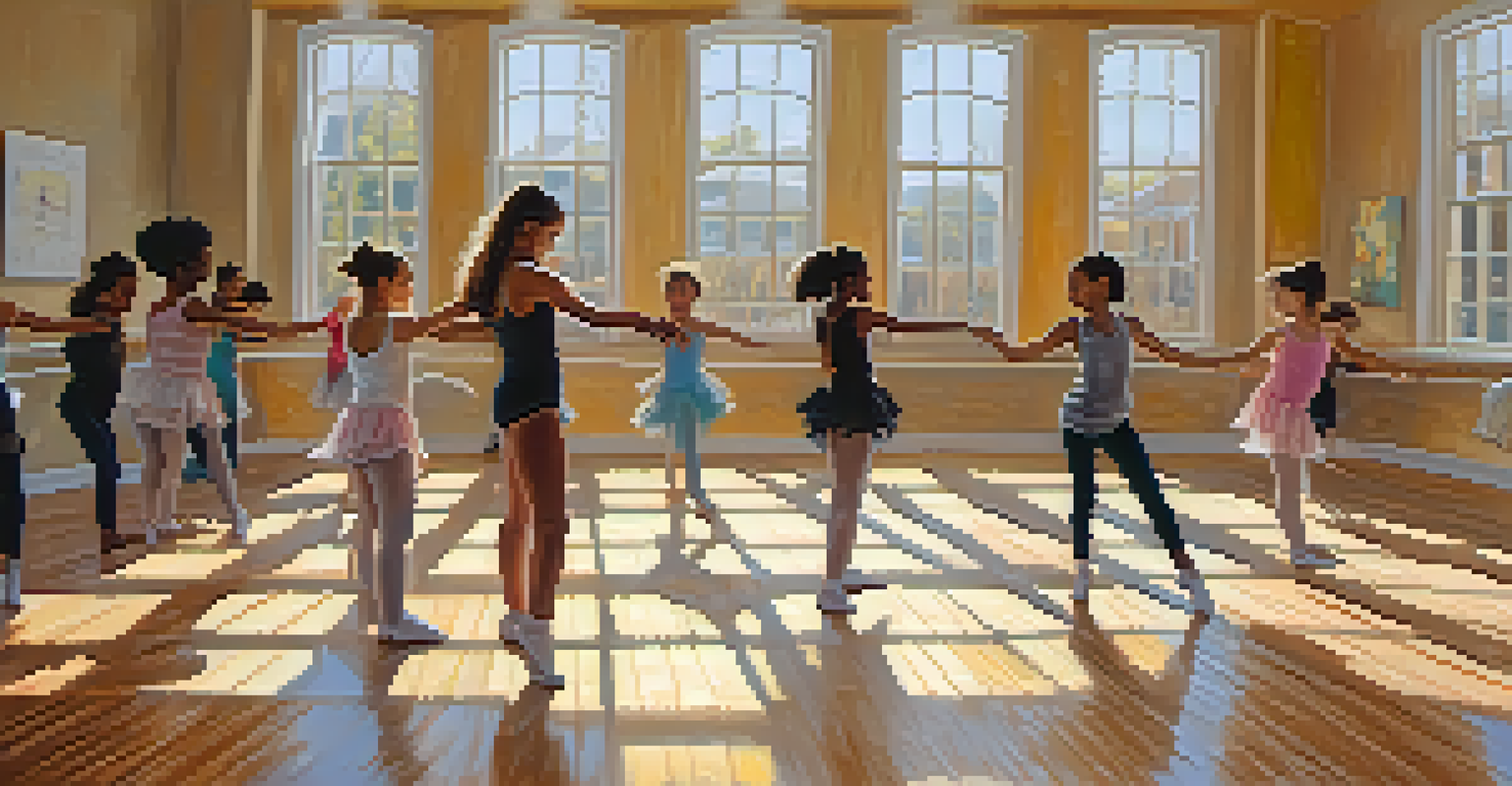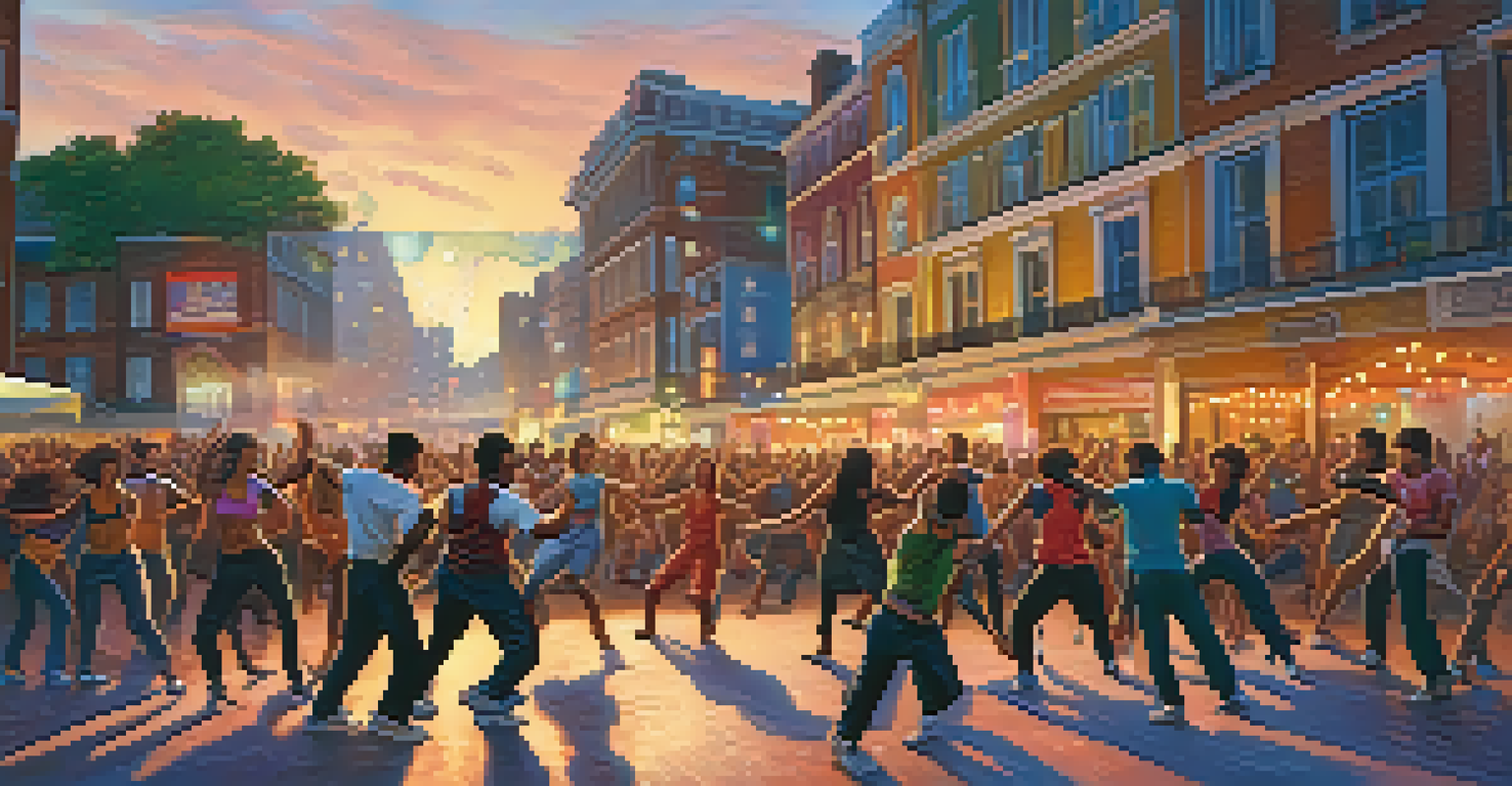Street Dance: The Catalyst for Urban Social Change

The Roots of Street Dance in Urban Communities
Street dance has deep roots in urban communities, emerging as a voice for youth culture and expression. Born in the streets, it reflects the stories and struggles of those who participate. From breakdancing in the Bronx to hip-hop in Los Angeles, these dance styles serve as a platform for creativity and connection.
Dance is the hidden language of the soul.
Each move tells a story, illustrating the challenges faced by dancers, such as economic hardship and social inequality. As a result, street dance becomes more than just a performance; it transforms into a powerful narrative of resilience. This cultural expression helps to build a sense of identity and pride among participants.
Moreover, street dance fosters a sense of belonging, creating communities where individuals can come together regardless of their backgrounds. This shared experience is crucial in urban settings, where often, divisions based on race, class, and culture can be stark. In this way, street dance acts as a unifying force.
Empowerment Through Expression and Performance
At its core, street dance empowers individuals to express themselves authentically. Dancers often use their bodies to convey emotions and tell stories, allowing them to process their experiences. This form of self-expression can be incredibly liberating, especially for those who feel marginalized in society.

Performing in public spaces also provides an opportunity for dancers to showcase their talents, gaining recognition and respect from their peers and the community. Through competitions and battles, they can prove their skills while also creating bonds with other dancers. These interactions foster mutual support and encouragement.
Street Dance Unites Urban Communities
Street dance serves as a powerful platform for creativity and connection, bringing together individuals from diverse backgrounds and fostering a sense of belonging.
Additionally, street dance encourages the development of leadership skills. Many dancers take on roles as mentors or instructors, guiding younger generations through the art form. This mentorship not only nurtures talent but also instills a sense of responsibility, further strengthening community ties.
Challenging Social Norms and Stereotypes
Street dance serves as a platform for challenging societal norms and stereotypes. Many dancers use their art to address issues such as racism, sexism, and poverty, making powerful statements through their movements. By confronting these topics head-on, they push back against prejudice and discrimination.
The purpose of art is not a rarified, intellectual distillate; it is life, intensified, and lifted to a level of significance that is not true of ordinary life.
For example, performances may incorporate themes that highlight social injustices, prompting audiences to reflect on their beliefs and attitudes. In this way, street dance not only entertains but also educates, sparking conversations about critical social issues. These dialogues can lead to a greater awareness and understanding within communities.
Furthermore, street dance promotes inclusivity by welcoming individuals from diverse backgrounds. As dancers come together to share their experiences, they break down barriers and foster unity. This collective effort can lead to real change, as communities begin to challenge the status quo.
Building Community Through Collaboration
Collaboration is at the heart of street dance, bringing artists together to create and innovate. Dancers often form crews or collectives, working together to develop new routines and styles. This teamwork fosters camaraderie and encourages creative exploration, pushing the boundaries of the art form.
Events like dance battles and showcases provide opportunities for collaboration beyond the local community. Dancers can connect with others from different regions or even countries, sharing ideas and techniques. These interactions enrich their skills and broaden their perspectives, ultimately benefiting their home communities.
Empowerment Through Self-Expression
Through authentic self-expression and performance, street dance empowers individuals, allowing them to process experiences and build leadership skills within their communities.
Moreover, collaborative projects often extend into broader social initiatives, such as workshops or community outreach programs. By sharing their passion for dance, artists can inspire others and promote positive change. This ripple effect reinforces the power of community in driving social transformation.
Street Dance as a Tool for Youth Engagement
Street dance plays a vital role in engaging youth, providing an outlet for creativity and self-expression. Many young people are drawn to the vibrant energy of street dance, finding joy and purpose within it. This engagement can steer them away from negative influences, fostering a sense of belonging.
Programs that incorporate street dance often emphasize discipline, teamwork, and personal development. Through structured classes and workshops, youth learn valuable life skills such as perseverance and resilience. These lessons extend beyond the dance floor, equipping them for future challenges.
In addition, street dance can serve as a gateway to other opportunities, such as scholarships or professional performances. By investing in youth through dance, communities can help shape a brighter future. This emphasis on empowerment can lead to lasting positive change in the lives of young dancers.
Creating Safe Spaces for Expression and Growth
As street dance continues to thrive, creating safe spaces for expression becomes essential. These environments allow dancers to explore their creativity without fear of judgment. Studios, community centers, and outdoor venues can all serve as welcoming spaces for practice and performance.
Safe spaces also encourage open dialogue and support among dancers. In these environments, individuals can share their experiences, struggles, and triumphs, fostering a sense of solidarity. This emotional connection is crucial for personal growth and community building.
Challenging Norms Through Art
Street dance acts as a medium for addressing social issues, promoting inclusivity, and sparking important conversations about racism, sexism, and inequality.
Moreover, by prioritizing safety and inclusivity, communities can cultivate a positive atmosphere that attracts new participants. As more individuals join the movement, the impact of street dance can continue to grow, further amplifying its potential for social change.
The Future of Street Dance and Urban Social Change
Looking ahead, street dance is poised to remain a powerful catalyst for urban social change. As global connectivity increases, dancers can share their stories and styles with audiences worldwide. This exchange of ideas fosters a greater understanding of diverse cultures and issues, amplifying the impact of street dance.
Furthermore, as more organizations recognize the value of street dance in community development, funding and support for programs will likely increase. This investment can lead to expanded opportunities for dancers, ultimately enriching their lives and communities. It also emphasizes the importance of arts education in fostering social change.

Ultimately, the future of street dance lies in its ability to adapt and evolve while staying true to its roots. As long as there are passionate individuals willing to express themselves, street dance will remain a vital force for transformation. This enduring legacy will continue to inspire generations to come.